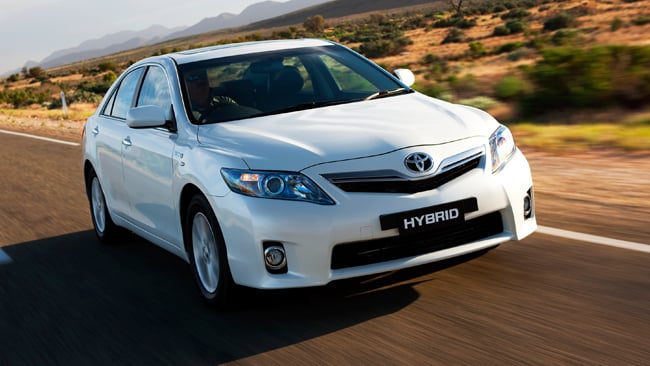It’s all too easy to get caught in the political whirr surrounding this Oz-built Hybrid Camry.Prime Minister Kevin Rudd is championing the petrol-electric Toyota as the biggest thing since the Holden 48/215, Australia’s first locally-built car, launched in 1948. That might be shaking the sauce bottle a bit, but you kinda have to talk up the product into which you’ve invested $40 million of taxpayers’ money.What’s immediately clear, though, is that the Camry – king of averages, queen of the conservatives – finally has a genuine USP. Nothing in the Hybrid Camry’s $35-40K price bracket can blend five-seat family car space with 6.0L/100km ADR81 fuel economy and 142g/km CO2 emissions rating.The regular Camry’s locally-manufactured 117kW/218Nm 2AZ-FE four-pot donk and five-speed auto have been replaced by a fully imported petrol-electric drivetrain hooked up to a CVT transmission. The same-size 2.4-litre petrol engine is heavily based on the Oz-built unit, but features the same efficiency-enhancing Atkinson combustion cycle as the Prius.Power and torque outputs drop to 110kW and 187Nm, but are quickly boosted by the 105kW/270Nm from one of the two motor generators (MG1 acts as a generator to create electricity, and as the starter motor for the petrol engine; MG2 is the sole driving motor).The system works as a parallel hybrid; the powertrain can run as petrol-only, electric-only or both, depending on the situation.Toyota claims the petrol-electric combo is a full 1.0sec quicker to 100km/h than the petrol-only car (9.5s) and that weight distribution is a near perfect 50:50. The Hybrid is also the first locally-built car to get electric-steer, regenerative braking and electric air-con.Hybrid Camry will be offered in two grades: $35K base and $39K Luxury. The entry-level car is based on the ($2500 cheaper) petrol Ateva, and includes 16in alloys, fog lights, six airbags, ESP, rear-view camera with parking sensors and dual-zone climate control. Luxury spec adds leather trim, power front seats, auto-dimming rear-view mirror, rain-sensing wipers and rear lip spoiler, with sat-nav, and sunroof optional extras.Toyota claims its chassis engineers worked hard to make Hybrid Camry a better drive than its petrol sibling, seeking improved body control and better on-centre steering feel – two of the petrol-only Camry’s biggest shortcomings.Front and rear spring stiffness has been increased by 8.5 and 12.5 percent respectively, and damping is 10 percent firmer. On the road, the changes are definitely for the better, but (surprise, surprise) Hybrid Camry isn’t a driver’s car.Most successful is the revised suspension tune. Ride quality is quite firm, but the Hybrid feels much less floaty over scarred arterials or undulating backroads, and is therefore both more reassuring for the driver and comfortable for passengers.Less successful is the electric-steer set-up, which, while definitely sharper on-centre, has a treacly, artificial resistance and vagueness as lock is wound on. The Hybrid’s handling falls somewhere in between; it’s still a bit too pushy at the front end, and lacks the balance and crispness of the similarly-sized Mondeo. For people who enjoy driving, the TDCi version of Ford’s full-size Euro-import (rated at 7.3L/100km) is clearly worth the extra fuel spend.But let’s not take anything away from what is essentially a compelling package. Roomy, hugely efficient and affordable; it’s no 48/215, but, finally, this is a Camry you’d be happy to recommend to your neighbour.





